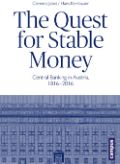Two books on 200 years of central banking in Austria
(, Vienna)In its bicentennial year, the OeNB presents two books that portray its history and highlight 200 years of Austrian economic and monetary policies
The Oesterreichische Nationalbank (OeNB) was founded 200 years ago, in 1816. It is commemorating this anniversary through a series of events throughout 2016, to inform about its tasks and its historical relevance for Austria. One of the first highlights is the launch of two historical volumes on Thursday, January 28, 2016, on the OeNB’s premises. These two books – which will be presented by OeNB President Claus J. Raidl together with representatives of the two publishing houses, Brandstätter and Campus – put the spotlight on the OeNB’s long and varied history and discuss the history of monetary policy in Austria from two different perspectives.

Memories of a Central Bank. Oesterreichische Nationalbank. Since 1816 (Brandstätter)
This volume was designed to “tell the story of the OeNB from the beginning to the present time in an engaging manner and through pictures. On some 200 pages, readers will find highly accessible information, great images and descriptive visuals,” explains OeNB President Raidl. “The book contains vignettes of workaday life at the central bank and previously unpublished material, thus offering stunning insights and a unique panorama of the central bank’s past and present.”
Each chapter provides the historical background essential for understanding the political, economic and social conditions under which the central bank acted at the time. Furthermore, timelines provide short summaries for quick orientation. Add to this facts and figures on the OeNB’s buildings, organization and staffing, for insights into the internal workings of the bank.
Numerous boxes single out highlights such as Austria’s smartest counterfeiter of banknotes in the 19th century, “The first company physician” or, a more recent event, “Fire! Fire! The bank is burning.” Among other things, the book also covers the changing role of women at the OeNB, milestones and pioneering achievements of the OeNB in banknote printing, often cumbersome money transports and the speeding up of payments.
This book is the work of a team of authors, namely Walter Antonowicz, Claudia Köpf and Bernhard Mussak (from the OeNB’s Bank History Archives) and Elisabeth Dutz (who added the chapters that deal with architecture, having done extensive research into the OeNB’s building history).
In the past three years, a team of bank and publishing house experts have worked closely on designing, drafting, editing and producing the book, explains Nikolaus Brandstätter, Director of Brandstätter Publishing. “Our project managers, authors, editors, translators and designers and layouters were a great team and they did an excellent job in nurturing the book through its many stages.” The book has been published in German and English (price: € 34.90).

The Quest for Stable Money. Central Banking in Austria 1816–2016 (Campus)
This book is the scholarly part of the OeNB’s bicentennial books. President Raidl: “Its two authors are Clemens Jobst, lead economist in the OeNB’s Department of Economic Analysis and Research, and Hans Kernbauer, from the Vienna University of Economics and Business. In other words, the book was authored by two renowned experts on 19th and 20th monetary history who at the same time deal with current monetary policy issues on a day-to-day basis. Thus, one of their biggest assets in writing this volume was their ability to read the past in the light of the present.”
As OeNB Governor Ewald Nowotny underlined talking to ORF journalist Gerhard Jelinek, the two authors show that “that notwithstanding the manifold changes in the framework within the OeNB has been working, today’s challenges are in fact recurring themes in the narrative of the OeNB’s history. And the reason is that central bank policymaking has typically been guided by two overarching objectives: securing the stability of the currency and securing the stability of the financial system. Among other things, the book also adds prominence to the relationship between the OeNB and commercial banks, which was largely neglected in past works.”
Governor Nowotny moreover emphasized that the production of the two bicentennial books was also a welcome occasion to revisit the many activities of the OeNB and the history and legacy of monetary policymaking, and to review the services and benefits the OeNB has provided for the economy and the general public over time. The bicentennial was thus also an occasion to showcase parallels to current developments and to do draw lessons from the past.
The scholarly book was produced by Campus Publishers, Frankfurt am Main/Germany and has also been published in German and English (price: € 29.90).
To order the OeNB’s bicentennial books, contact Christian Brandstätter Publishers for the illustrated book on the OeNB’s history and Campus Publishers for the scholarly book on monetary policy in Austria.
